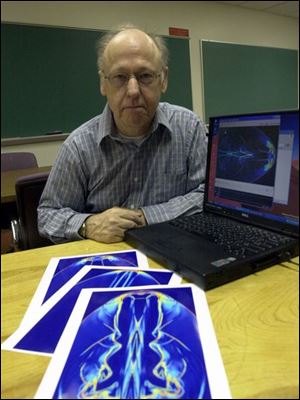
MCO a pioneer in area schools' quest for speed
11/5/2001
Dr. Comer Duncan of Bowling Green State University says Internet2 will allow him to correspond with his colleagues.
Dr. Bob Blumenthal has a hunch: If you like the Internet, you'll love the sequel.
Sitting in his Toledo office on the campus of the Medical College of Ohio, Dr. Blumenthal enthusiastically described Internet2, a consortium led by more than 180 universities in partnership with industry and government to develop the next generation of the Internet.
“I think it could be a quantum leap,” the professor of microbiology and immunology says. “This is cutting edge.” And it's coming to northwest Ohio.
With Dr. Blumenthal's help, MCO joined Internet2 last month. Bowling Green State University plans to log on in January, and the University of Toledo is exploring the possibility of joining before too long.
Created in 1996, Internet2 members commit to developing and deploying advanced network applications and technology.
While not a separate physical network, Internet2 carries applications that take advantage of fiber optics, Gigabit routers, and networking protocols that allow researchers to get their work done faster.
To users, this means speed - potentially thousands of times faster than typical Internet connections.
Academics are particularly interested in the technology because it allows them to share huge amounts of information quickly. Ohio State University, Miami University, and Kent State University are among the schools in the state that have become Internet2 members so far.
Lack of speed has been a hurdle for Dr. Comer Duncan at BGSU.
The physics and astronomy professor has spent years studying the jets of gas that issue from the center of some galaxies and generating numerical models to illustrate the process in three-dimensional simulations.
His data sets are so large that he rarely transfers files back and forth between his colleagues in Michigan and Missouri or attempts to alter simulations while they run.
“It was just silly to do it,” Dr. Duncan said. “It took five years of work just to get the data to write a paper. Had we had Internet2 with the same computational tools that we have now, we would have been far beyond that.”
Soon he will, thanks to a $150,000 grant from the National Science Foundation he received to help BGSU join Internet2.
The university is expected to pay more than $200,000 over the next two years that will go toward networking, membership fees, and sending faculty to Internet2 summits, said Dr. Linda Dobb, executive vice president.
BGSU has spent about $50 million upgrading its technology infrastructure as part of its BGsupernet program.
“Part of having that investment is not just that it improves our on-campus speed and reliability,” she said. “The supernet was done with an eye toward doing this.”
In addition to helping researchers deal with large amounts of information, Internet2 is expected to help BGSU get heavily involved in digital imaging, she said.
At MCO, Dr. Blumenthal aims to focus on teleconferencing. It should be particularly helpful as part of the partnership developing between MCO, UT, and BGSU in bioinformatics, he said.
Bioinformatics is a melding of biology and computer science in which scientists analyze and study billions of genes and predict biological behavior using powerful computers.
“Teleconferencing now isn't very good,” Dr. Blumenthal said. “The current Internet is just like taking FedEx and bulk mail and just throwing it together and saying `first come, first serve'.”
Internet2 prioritizes data intelligently and allows teleconferencing without the complications or herky-jerky video and audio that typify it now.
Professors from around the world could teach or provide seminars, and researchers could access microscopes and telescopes thousands of miles away. Having these options is especially important to smaller schools like MCO that don't have enormous resources, he said.
The college expects to spend about $200,000 for equipment before remote teaching begins this summer, he said.
Joe Drees, director of network services for UT, said research faculty at the university are in the process of writing proposals about projects that might require Internet2.
“Internet2 membership requires a significant justification to say why you should be on it,” he said. “It's got to be research and application related, and that has to come from our faculty.”
Membership fees could run UT more than $110,000 a year, he said, which means the university would have to find some significant spare change at a time when the state is cutting its budget for higher education.
The advantages of Internet2 might not be available to consumers just yet, but before long, video conferencing and other applications could be as easy and convenient as sending e-mail, said Gary Wood, a spokesman for Internet2 in Washington.
“Three to five years from now when we go out to buy a network-connected device, whether it be a PC or something that looks like a television on steroids, we'll be able to use capabilities that have taken advantage of all the work that the Internet2 community has done,” he said.
Dr. Blumenthal agreed that it's probably only a matter of time before Internet2 achieves wider use.
“It think in the long run, it's going to take over completely,” he said.